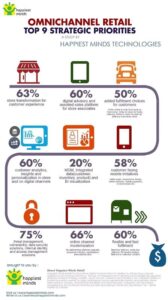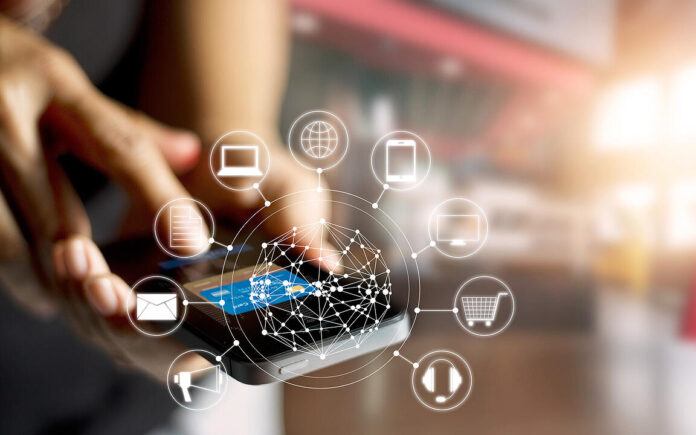A lot of time people confuse omnichannel with multichannel retail. There is no major difference, though the thin line lies in the customer-centric and seamless shopping experience provided by the omnichannel. It is an extension of multichannel.
Nowadays, everything we want, we can get at our fingertips, whether it’s a pencil, a car or a house. Time has changed and it has changed the shopping experience of customers across the globe. We no longer need to visit a shop or a market; our devices are the new market for us. We have got more than enough options to buy things and regardless of if it’s online, offline, or a combination of both. This combination is known as the omnichannel.
Omni comes from the Latin word omnis which means all; at all places. When you can find an item in stores, websites, apps, social media, almost everywhere and can purchase the same as per your preference, i.e., can buy a product online but pick it up from the local store and vice versa, it’s the omnichannel you are using. You can also use the after service online or offline or a combination of both. The simplest example of it is Amazon.
What is omnichannel retail?
The customer-centric and seamless shopping experience provided by the omnichannel. In multichannel retail, too, customers can shop from stores, social media, apps, etc. The awareness and interactions with customers here matters the most. Though the matter between omni and multichannel is that the omnichannel binds all the shopping mediums into one with an online presence and offline touchpoints.
Omnichannel retail increases the comfort of customers. After all, it is convenient to check out online for your favorite brand at a discount and get the option of picking it up from a local shop or vice versa, right?
 In omnichannel retail, the latest technologies such as augmented reality (AR), virtual reality (VR) and data collection and analysis play vital roles. We can take the example of Lenskart here. The Lenskart app has the option that allows users to click a picture; using the VR, they let the users see how a frame would look on their face from various angles. Later the customer can buy it online or can visit the store.
In omnichannel retail, the latest technologies such as augmented reality (AR), virtual reality (VR) and data collection and analysis play vital roles. We can take the example of Lenskart here. The Lenskart app has the option that allows users to click a picture; using the VR, they let the users see how a frame would look on their face from various angles. Later the customer can buy it online or can visit the store.
Nowadays, wherever we go, data collection has a presence. You would have noticed and experienced restaurants asking for your contact details, anniversary/birthday details, etc. Even when you visit a site, they ask you to accept the cookie policies or may require you to sign up. All these things are interconnected with each other to attract customers. You may start seeing watches on all your social media if you would have visited a website for watches, i.e. Flipkart. That too the same brand of watches. You may receive emails offering discounts or coupon codes, etc. That’s the power of creating a customer-centric retail channel.
A few particulars are essential for successful omnichannel retail which includes, engaging customers, analyzing customer preferences and behaviors, running a loyalty program, integrating online and offline shopping, better customer services (chatbots), email promotions, etc. The list goes on.
How prevalent is it?
We use omnichannel retail more frequently than we think we use. Amazon, Flipkart, Pepperfry, Starbucks, Disney, etc., are the famous brands implementing this strategy successfully. Amazon’s acquisition of Whole Foods Market in the US, supermarket chain More, and investment in fashion retailer Shoppers Stop in India indicate its intent to build an omnichannel strategy. Similarly, Alibaba group has invested in Sun Art Retail group.
As per stats, companies that have better omnichannel customer engagement strategies retain on average 89 per cent of their customers which stands only at 33 per cent for companies that have weak or no omnichannel retail in place.
Around 68 per cent of millennials now demand the convenience of an omnichannel approach during their shopping journey. Whereas, 84 per cent of baby boomers prefer to buy products from stores. According to a study by Harvard Business Review (HBR) done on 46,000 shoppers, only 7 per cent of people preferred shopping exclusively online. For store only shopping, the percentage stood at 23. While 73 per cent of people voted for multiple channels for shopping.
 Does it have a future?
Does it have a future?
The pace at which the retailers are trying the omnichannel approach is great, but it will take some time to spread omnichannel retail across the globe, the way multichannel is being used at present. The transition to omnichannel is not only a result of people buying not only regular household stuff but also high value products such as cars, white goods and luxury goods. Especially in cars many new cars and second hand car dealers are opting to provide their customers with quality online and in-shop experiences in an attempt to keep up with customer expectations.
In the future, more retailers would opt for omnichannel retail, but it will have to be a holistic approach including the age-old and proven fundamentals of retail including location, quality of products, brand positioning, customer support and interactions, personalization, overall shopping experience leading to improved customer retention and loyalty. This strategy does demand investment, but its future will secure the retailers from being disrupted and has long-term payouts.
Just make your customer the hero of your story, and you are surely going to have a blockbuster journey. #KhabarLive #hydnews







